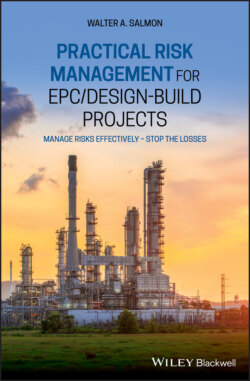Читать книгу Practical Risk Management for EPC / Design-Build Projects - Walter A. Salmon - Страница 35
3.5 Greater Risks for EPC Contractors
ОглавлениеThe scope of work and the range of responsibilities and risks placed on the Contractor will vary from one EPC Project to the next. EPC Projects of themselves are risky enough for the Contractor, even if they are of the more preferable (from the Contractor's perspective) reimbursable type contracts (where the Contractor is paid for all costs involved in constructing the Project plus an agreed lump-sum or percentage addition to cover overheads and profit). As observed by Watt, ‘Since the cost of the project is reimbursable, the contractor has much less risk associated with cost increases’.6 However, all too often nowadays, Employers are insisting that the Contract Price is lump-sum in nature and fixed in all respects (i.e. no increase is payable to the Contractor for inflation, fluctuations in currency exchange rates, etc.). This means that every extra cent spent must come out of the Contractor's own pocket, sometimes even if the Employer appears to be the direct cause of the unexpected expenditure.
Some additional items added to the list of responsibilities for the EPC Contractor can increase the magnitude of the risks almost exponentially. Examples are such things as: (i) validation of the Conceptual Design and (ii) the provision of ‘single source’ specialist equipment that is fundamental to the required outputs from the completed facility (such as, for example, the Gas Turbine Generators for a Power Plant Project). There are far more possibilities beyond those limited examples. This situation is aggravated even more where the Contractor is also responsible for meeting the Guaranteed Performance Outputs of single source equipment. I have even worked on a Project where, albeit in a roundabout way, the Employer tried (unsuccessfully) to make the Contractor responsible for the quality of the gas that the Employer was responsible for supplying for fuel purposes, and upon which the required outputs from the facility were highly dependent. Such is the lot of the EPC Contractor, all too often ‘not a happy one’.7
If the Employer also insists on an unusually short time-frame for completion (with substantial Liquidated Damages payable by the Contractor if the Project is completed late), then truly effective management of the risks involved becomes an absolutely essential task for the Contractor to perform if the Contractor's expected profit is going to have any chance of being achieved. The Employer will inevitably be very strict on adherence to the completion date in the situation where the Employer is liable to pay heavy penalties to any third parties in the event of delayed completion of the Project. That will be especially so where contractual promises have been made by the Employer to other companies relying on the output date from the completed facility to be achieved.
To put the risks of the above scenarios into perspective, consider how much easier the task of the Contractor would be if the construction implementation work were to be set up under the following ideal risk reduction Traditional Contracting scenario (from the point of view of the Contractor):
1 all the Engineering work is to be undertaken by others (including the Detailed Design work),
2 all key equipment items are to be purchased directly from the Vendors by the Employer and installed under separate Subcontracts issued by the Employer,
3 specialist services installations too are to be undertaken by Subcontractors who will be tied into Subcontracts issued by the Employer,
4 a very reasonable time-frame for completion will be allowed, and
5 no Guaranteed Performance Outputs of any sort are required from the Contractor.
Even under the above setting of much reduced risks, a Contractor would still face many risk situations which, if they materialised, would prevent achievement of the expected profit level. Many Projects under the Traditional Contracting approach do in fact have many of those idealistic elements on board. Sadly, however, for Projects considered overall (construction work orientated), KPMG reported in March 2015 that ‘Owners continue to experience project failures: 53% suffered one or more underperforming projects in the previous year. For energy and natural resources and public sector respondents the figures were 71% and 90% respectively. Only 31% of all respondents' projects came within 10% of budget in the past 3 years. Just 25% of projects came within 10% of their original deadlines in the past 3 years’.8 It is therefore very obvious that EPC Projects require a much more robust approach to Project Risk Management if the Managers of a Project are going to be able to hold their heads high when the Final Acceptance Certificate is issued.
